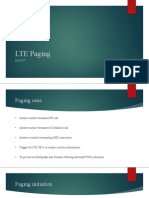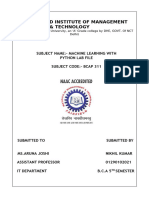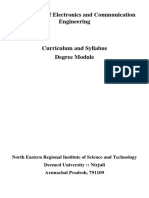Lab Program (SVM From Scratch)
Uploaded by
tabassumtayiba786Lab Program (SVM From Scratch)
Uploaded by
tabassumtayiba786SVM from Scratch
Algorithm Explanation
1. Objective: Find a hyperplane that separates classes with the maximum margin. This
hyperplane can be represented by a weight vector w and bias b.
2. Loss Function: We use a hinge loss function and apply gradient descent to minimize the loss.
3. Gradient Descent: We iteratively update the weights and bias based on the gradients of the
loss function.
python
Copy code
import numpy as np
import pandas as pd
class SVM:
def __init__(self, learning_rate=0.001, lambda_param=0.01,
n_iters=1000):
self.lr = learning_rate
self.lambda_param = lambda_param
self.n_iters = n_iters
self.w = None
self.b = None
def fit(self, X, y):
"""Train SVM using gradient descent"""
n_samples, n_features = X.shape
y_ = np.where(y <= 0, -1, 1) # Convert labels to -1, 1
self.w = np.zeros(n_features)
self.b = 0
for _ in range(self.n_iters):
for idx, x_i in enumerate(X):
condition = y_[idx] * (np.dot(x_i, self.w) - self.b) >= 1
if condition:
self.w -= self.lr * (2 * self.lambda_param * self.w)
else:
self.w -= self.lr * (2 * self.lambda_param * self.w -
np.dot(x_i, y_[idx]))
self.b -= self.lr * y_[idx]
def predict(self, X):
"""Predict the class of input data"""
approx = np.dot(X, self.w) - self.b
return np.sign(approx)
# Load CSV file
data = pd.read_csv('data.csv')
X = data[['Feature1', 'Feature2']].values
y = data['Label'].values # Labels should be -1 and 1 for binary
classification
# Train SVM from scratch
svm = SVM(learning_rate=0.001, lambda_param=0.01, n_iters=1000)
svm.fit(X, y)
predictions = svm.predict(X)
# Print the predicted labels
print('Predictions:', predictions)
Explanation:
• Loss Function: We apply hinge loss to penalize misclassifications and maximize the margin
between classes.
• Weight Update: We use gradient descent to adjust the weight vector w and bias b after each
iteration.
• Prediction: The class prediction is based on the sign of the dot product of w and input data X.
SVM Using sklearn
Using sklearn, SVM can be applied easily with minimal code.
python
Copy code
from sklearn import svm
from sklearn.model_selection import train_test_split
from sklearn.metrics import accuracy_score
import pandas as pd
# Load CSV file
data = pd.read_csv('data.csv')
X = data[['Feature1', 'Feature2']].values
y = data['Label'].values # Make sure labels are -1 and 1 for binary
classification
# Split the data into training and testing sets
X_train, X_test, y_train, y_test = train_test_split(X, y, test_size=0.2)
# Apply SVM using sklearn
clf = svm.SVC(kernel='linear') # Linear kernel for binary classification
clf.fit(X_train, y_train)
predictions = clf.predict(X_test)
# Check accuracy
accuracy = accuracy_score(y_test, predictions)
print('Accuracy:', accuracy)
Explanation:
• Kernel: The linear kernel is used for basic linear classification. For more complex data,
other kernels like rbf (Radial Basis Function) can be used.
• Train-Test Split: The dataset is split into training and testing sets to evaluate the performance
of the model.
• Accuracy: The accuracy is calculated to assess the classifier's performance.
You might also like
- 7_3_6_Building_Support_Vector_Machine_Classifier_from_Scratch_in_PythonNo ratings yet7_3_6_Building_Support_Vector_Machine_Classifier_from_Scratch_in_Python3 pages
- Using A Three Layer Deep Neural Network To Solve An Unsupervised Learning ProblemNo ratings yetUsing A Three Layer Deep Neural Network To Solve An Unsupervised Learning Problem13 pages
- Nibedita Dehury, 123CE0079, Assignment 7No ratings yetNibedita Dehury, 123CE0079, Assignment 715 pages
- Principles Involved in Handwriting Identification100% (3)Principles Involved in Handwriting Identification2 pages
- Customer Perception Towards Chinese Mobile Brands in Indian Market With Special Reference To Cuddalore DistrictNo ratings yetCustomer Perception Towards Chinese Mobile Brands in Indian Market With Special Reference To Cuddalore District97 pages
- كتاب أساسيات جودة الرعاية الصحية و أمان المريض المعهد 1100% (1)كتاب أساسيات جودة الرعاية الصحية و أمان المريض المعهد 1133 pages
- Insert OJT Provider Name Here: LWDA 12: On-the-Job Training (OJT) Training PlanNo ratings yetInsert OJT Provider Name Here: LWDA 12: On-the-Job Training (OJT) Training Plan3 pages
- Shutdown Ipcs in The Sitop Psu8600 Buffer ModeNo ratings yetShutdown Ipcs in The Sitop Psu8600 Buffer Mode37 pages
- Enneagram: TWO: A. SELF-PRESERVATION: Focus On PrivilegeNo ratings yetEnneagram: TWO: A. SELF-PRESERVATION: Focus On Privilege4 pages

























































































